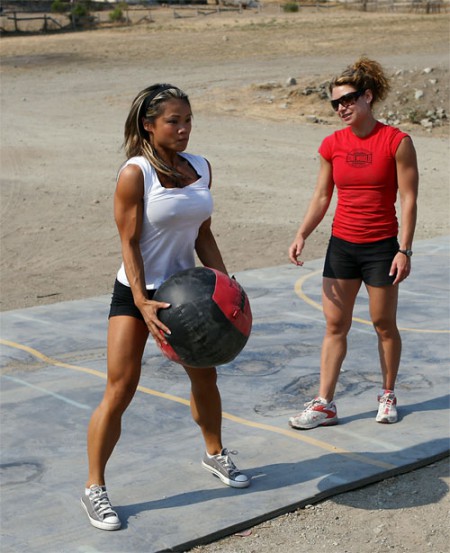Female strength training is different than a males. Is it because of gender roles or emotion? No, it’s because of the reality of physiology. You see, women have less than one tenth (1/10) of the testosterone as a male. Ehh, maybe it depends on what kind of male we’re talking about…at least guys that lift.
We understand this means women won’t get “bulky” or grow muscle like a gorilla, yet it changes how they react to training. Let’s not worry about what hormone does what — I’m not an endocrinologist and the hormone function of women is more complicated than quantum theory. Let’s just look at the resultant effects.
To Grow — Muslcesize!
Females develop muscular structure with higher repetition programs. This is an observation across many different types of training. Figure/fitness competitors typically approach training like “bodybuilding”, our quick summation of higher repetition training in both compound and isolation exercises and lifts. Many are quick to say, “Yeah, and they’re on steroids/PEDs,” but look at their training modality. It typically hits a lot of reps in a compound movement, then moves to more isolation work on the same muscles in the same session. It puts a lot of work and volume on that area.
 Now look at something like CrossFit. It’s an amusing stereotype to say, “CrossFit turns the men into women and the women into men.” It’s a bit unfair, but it sort of holds true. Go to bigger, higher performing facilities and you’ll see beautifully muscled women (which makes them look shapely and womenly as opposed to bulky or extremely muscular) who might be working along side shredded guys who weigh only 20 or 30 pounds more than that girl. Again, this isn’t entirely fair since the higher performing male athletes are anywhere from 190 to 220 pounds, but this isn’t about the guys. The women develop good musculature in CrossFit because a) they’re performing effecitve compound movements and b) they are doing them with high repetitions.
Now look at something like CrossFit. It’s an amusing stereotype to say, “CrossFit turns the men into women and the women into men.” It’s a bit unfair, but it sort of holds true. Go to bigger, higher performing facilities and you’ll see beautifully muscled women (which makes them look shapely and womenly as opposed to bulky or extremely muscular) who might be working along side shredded guys who weigh only 20 or 30 pounds more than that girl. Again, this isn’t entirely fair since the higher performing male athletes are anywhere from 190 to 220 pounds, but this isn’t about the guys. The women develop good musculature in CrossFit because a) they’re performing effecitve compound movements and b) they are doing them with high repetitions.
If you want musculature to grow, or become shapely, then perform higher reps. This is easily done in a strength program by doing a some back off sets with higher repetitions after the initial work sets are done (or by adding in appropriately structured conditioning work).
Higher Percentages?
It’s noticeable that females can not only do more work than their male counterparts, but can lift more reps at a higher percentage of their max. These two concepts exist because of the hormonal differences which make a female’s neuromuscular efficiency lower than a male’s. This is a term that indicates how efficiently motor units function. A motor unit consists of a group of muscle fibers that are innervated by the same motor neuron. How many muscle fibers that a motor neuron is connected to is dependent on the type of muscle. For example, the gastrocnemius (hoof-looking portion of the calf) has around 2,000 muscle fibers while some optic muscles (in the eye) only have a few. The fewer the muscle fibers, the more precise and deft the movement (think of the delicate movements of the fingers compared to the knee).
When a motor neuron reaches its action potential, all of the fibers associated with it will innervate (this is the “all-or-none law”). However, given a movement, not all motor units will be activated. Neuromuscular efficiency depends on the number of motor units, the rate of activation, and how the innervation functions with other muscle groupings (including antagonistic muscles).
The hell does all of that mean? A greater neuromuscular efficiency means that the body is more efficient at applying force and executing movement. It’s the same reason why a new trainee might awkwardly execute a herky-jerky squat, but then after getting plenty of repetitions (i.e. practice), their technique will smooth into efficient mechanics.
In the case of a woman, it means that she is never truly applying as much force as her muscles can because her motor neurons can’t innervate everything properly to do so. When a girl hits 90% of her max for 5 or 6 reps (something that a guy might hit for a set of 3), it’s because what we are calling 90% is actually lower than what her true 90% is. Women can lift more reps with higher percentages than men because they aren’t as neuromuscularly efficient as men.
A women’s training will need to be modified beyond the “novice stages” to account for this difference in efficiency. In the Texas Method, for example, a women can (and will need to) use a greater intensity on her Volume Day in order to get enough of a stress. If you’ve read my books, you know that the average intensity of the Volume Day shouldn’t exceed about 85% of the Intensity Day’s (i.e. if the Intensity day is 500×3, then the average of the Volume Day work sets shouldn’t be much higher than 425). But a female can handle 85% but eventually will need a greater percentage to get an adaptive stress. For example, if a female is squatting 225×3, her Volume Day sets could approach 90%, which is around 200x5x3.
Note: These percentages are not calculating total volume and they are relative to the weight that is done on the Intensity Day. They are just a gauge for controlling the programming. If you’re confused or want to know more, then purchase the books.
This same concept will apply in other programs, but as coaches we need to take note, especially in maximal lifting scenarios. If a girl looks good on a heavy set of 5, we may think in “male terms” and think she has a lot of weight left on the bar for a 1RM. Yet her 1RM is going to be closer to her 5RM and 3RM than a guy’s. This is important to know in preparing attempts for a meet, but also choosing third attempts based on difficulty. If a second attempt looks regular, that female may not be able to make as large of a jump as you (and she) think she can. You women have probably noticed this; you’ll do a rep at a heavy weight and it feels fine. Then you go up ten pounds and you get stapled. It all has to do with neuromuscular efficiency. Women will vary in how much this effects them, but as a general rule the efficiency is lower than in their male counterparts. Experience will be the ultimate deciding factor, but in the mean time, be a bit conservative.
Since a woman is typically using a lower percentage of her max, she can handle more work than a guy would. This is noticeable when a gal isn’t necessarily fatigued after sets, or doesn’t seem fatigued throughout the session (sometimes this is the case because she’s limited on what she can do with correct technique). It’s not a big deal for women to tack on additional assistance exercises or high intensity conditioning; she’ll be able to recover and the higher repetitions will probably augment her strength gains.
Take note of these various important points: 1) women grow with reps, 2) women can complete more reps with high percentages of 1RM, 3) a woman’s 1RM ceiling doesn’t extend much beyond her rep maxes, and 4) a woman can handle more work in the programming. I hate the fact that I have to say this, but you guys leave me no choice: this doesn’t apply to everyone in every situation. However, on average it will be the case and knowing about these issues can help program strength or aesthetic improvements.


